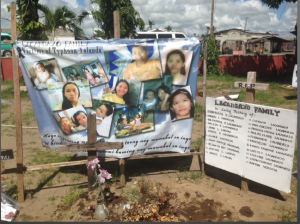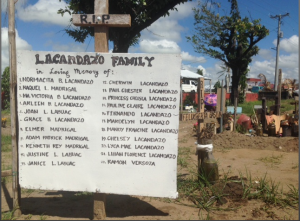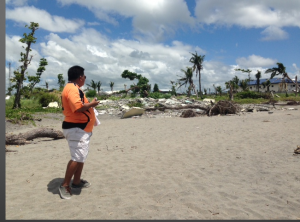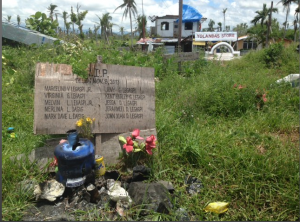 Text & Photos by Ariel Neidermeier
Text & Photos by Ariel Neidermeier
I spent my last day in Tacloban with my friend Pol. He drove me down the coast, showing me the destruction in the surrounding areas of the city.
On the way to his home town of Tanauan, we stopped in the barangay just south of Tacloban called Palo. Palo is also a coastal barangay that suffered massive destruction at the hands of Yolanda. We stopped at a local church where there is a mass grave site for the residents of Palo who died in the storm. There are mass grave sites all over Tacloban however many of them are unmarked. I had never been to a grave site with the names marked at each plot, reflecting the sheer magnitude of deaths from the storm.
In front of San Joaquin Church in Palo, large banners and signs mark the names of the dead. Some signs feature more than 20 names. “That means an entire family is buried in this plot,” Pol murmured as we passed a sign honoring the memory of the Lacandazo Family. I felt tears prick my eyes as we stopped and looked at the pictures of the family members next to the sign: mothers, fathers, children. I brushed them away silently as we got back in the car and kept going.
more than 20 names. “That means an entire family is buried in this plot,” Pol murmured as we passed a sign honoring the memory of the Lacandazo Family. I felt tears prick my eyes as we stopped and looked at the pictures of the family members next to the sign: mothers, fathers, children. I brushed them away silently as we got back in the car and kept going.
 Pol took me to his hometown of Tanauan and showed me where his family beach resort once stood before the storm. The La Vista Resort was a modest beach resort, with two stories and only three rooms for guests. Pol and his siblings built the structure 10 years ago. Today, it is nothing but a pile of rubble on the sandy coast of Tanauan.
Pol took me to his hometown of Tanauan and showed me where his family beach resort once stood before the storm. The La Vista Resort was a modest beach resort, with two stories and only three rooms for guests. Pol and his siblings built the structure 10 years ago. Today, it is nothing but a pile of rubble on the sandy coast of Tanauan.
We stood in front of the former building for a long time talking about Pol’s plans to rebuild one day. After a moment, he looked out into the ocean and said, “I used to go swimming every day but now I don’t want to go in that water after everything that’s happened.” Despite this brief expression of pain, Pol brushed it off, cracking another joke as he we got back into the car. I’ve noticed behavior like this throughout my time in the Philippines: survivors of the storm will talk about the pain, the destruction and the death and then make a joke and smile; easily shifting from hardship to joy. Nothing showcased this attitude more than another mass grave site we passed in Tanauan.
Behind it a resident had set up a small store, choosing to name it “Yolanda’s Store,” to poke fun at the grave site in front of it. It might seem morbid to some people, but for Filipinos it’s a way to laugh and smile through the pain. It’s a coping mechanism that shows a level of resilience that I have the utmost respect for.
front of it. It might seem morbid to some people, but for Filipinos it’s a way to laugh and smile through the pain. It’s a coping mechanism that shows a level of resilience that I have the utmost respect for.
As Pol drove me back to downtown Tacloban so I could catch my flight to Manila, a song came on the radio. I noticed the chorus included the words “Bangon Tacloban” which means “rise up Tacloban” in Tagalog. I looked over to see Pol humming the song. He knew all the words by heart. I couldn’t help but imagine the people of Tacloban singing the song, their voices rising up together.
(note from the editor: Ariel Neidermeir has spent three months in the Philippines volunteering with relief efforts for All Hands Volunteers. You can catch up with all of Ariel’s blogs from the Philippines these past three months on AsAmNews.)
